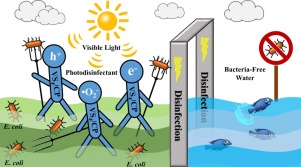Applied Catalysis B: Environment and Energy ( IF 22.1 ) Pub Date : 2017-10-28 , DOI: 10.1016/j.apcatb.2017.10.065 Baogang Zhang , Shiqiang Zou , Ruquan Cai , Min Li , Zhen He

|
Reliable and effective water disinfectants are of paramount importance to address mounting health concerns in drinking water. Herein, Vanadium Tetrasulfide (VS4) nanocomposites supported by different carbon materials, including VS4/CP (carbon powder), VS4/rGO (reduced graphene oxides), VS4/CF (carbon fiber), and VS4/CNT (carbon nanotube), were synthesized, comprehensively characterized, and investigated as photocatalytic disinfectants. Among them, the cost-effective and lattice-structure VS4/CP exhibited the best disinfection performance for removing E. coli (Gram-negative) under both simulated visible light and sunlight, with a maximum inactivation rate of 9.7 log at 0.1 g L−1 in 30 min. However, it was not very effective to eliminate S. aureus (Gram-positive bacteria) with a disinfection rate of 1.7 log inactivation in 30 min. Consistent disinfection performance was confirmed with four successive stability tests and over a wide range of E. coli density (6 log to 9 log CFU ml−1). The potential disinfection mechanism was studied on a subcellular level, indicating that membrane damage (via mineralization, lipid peroxidation and collapsed membrane potential) and penetration-induced intracellular damage including DNA degradation and decreased ATP level could be the main inactivation principles. Further photochemical investigation suggested that O2−, h+ and e− were crucial active species, and an acidic/neutral environment would favor the photocatalytic disinfection. These results have demonstrated effectiveness and potential applications of the developed VS4/CP nanocomposites in water disinfection.
中文翻译:

碳载四硫化钒纳米复合材料在可见光下高效对大肠杆菌进行光催化消毒
可靠,有效的水消毒剂对于解决饮用水中日益严重的健康问题至关重要。在此,由不同碳材料(包括VS 4 / CP(碳粉),VS 4 / rGO(还原石墨烯氧化物),VS 4 / CF(碳纤维)和VS 4 / CNT(碳纤维))支撑的四硫化钒(VS 4)纳米复合材料。碳纳米管),进行了合成,综合表征并作为光催化消毒剂进行了研究。其中,具有成本效益的晶格结构VS 4 / CP表现出最佳的去除大肠杆菌的消毒性能。在模拟可见光和日光下均处于(革兰氏阴性)状态,在30分钟内在0.1 g L -1下的最大失活率为9.7 log 。但是,在30分钟内以1.7 log灭活的消毒速率消除金黄色葡萄球菌(革兰氏阳性细菌)不是很有效。通过四次连续的稳定性测试并在大范围的大肠杆菌密度(6 log至9 log CFU ml -1)下确认了一致的消毒性能。)。在亚细胞水平上研究了潜在的消毒机理,表明膜破坏(通过矿化,脂质过氧化和膜电位下降)和渗透诱导的细胞内破坏(包括DNA降解和ATP含量降低)可能是主要的失活原理。另外光化学调查表明Ø 2 -,H +和E -是至关重要的活性物质和酸性/中性环境将有利于光催化消毒。这些结果证明了开发的VS 4 / CP纳米复合材料在水消毒中的有效性和潜在应用。


























 京公网安备 11010802027423号
京公网安备 11010802027423号